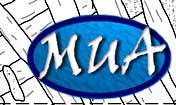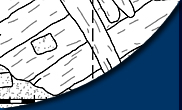
Great Weather, Great Finds in Pensacola Bay
June 15-19, 2009
By Marisa Foster, Mercedes Harrold, and Colleen Reese
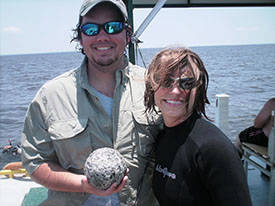
Team 3, Wes Perrine and Marisa Foster, show off the cannonball they excavated from the amidships unit. (Large View)
On Monday, the weather was promising with a gentle breeze and clear skies. The barge proved troublesome again, as the anchor line yet again severed just above its protective sheathing. Team 3 conducted a circle search for the anchor. They found it quickly; and while the anchor line was being secured in hopes of a better hold, a group of dolphins appeared and swam around within 10 to 15 feet of the barge and divers. Dredging then resumed in the stern and amidships. In the stern, or south unit, more hull structure was exposed, while in the amidships, several pieces of olive jar with resin were mapped in and excavated. With all the excitement of last week’s discovery of the cannonball-like coral, you can imagine our complete glee when Team 3 recovered what was unmistakably a stone cannonball from the very same unit, not far from the original coral piece. We were all pleased to know that the first cannon ball-like find would be reevaluated.
Tuesday was the first day of our new rotation. On Tuesday and Wednesday, four teams continued to work off the barge on EPII, while one team worked in the lab and another team learned survey techniques in Pensacola Bay and Bayou Texar. On EPII, we set a new anchor and replaced the line to prevent any more delays to the archaeology due to this problem. While excavating in the amidships unit, several more pieces of olive jar fragments were found. In the southern/stern unit, the teams completed the third 20cm level and mapped the exposed hull.
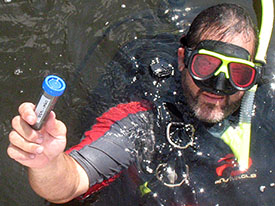
Baird Ullrey brings a sediment sample for Dr. Martin up from the south unit.
Teams 4 and 6 collected sediment samples from various locations around the EPII site, which will be used by Dr. Martin, a chemistry professor at UWF, for determining bacterial growth at various depths on the wreck and what chemical compounds the bacteria produce. Supervisors Colleen Reese and Jake Shidner will also collect samples for their studies on paleoethnobotany and shipboard pests. The survey team, Team 2, had a rather short day. This was due to the survey equipment encountering problems, but a crew from the communications department at UWF filmed the team using the survey equipment for a documentary being made about archaeology field schools. In the lab, Team 5 helped make drawings of artifacts found during previous field excavations as well as cataloging them.
The rotation from Tuesday continued into Wednesday. Team 3 went to the archaeological conservation lab, where they labeled and recorded artifacts before treatment. They started with artifacts from last year, working with metals and concretions first before moving to organics. Teams on EPII recovered more olive jar fragments in the amidships unit. One of these included a rim fragment that looked very similar to one found the day before. On the second dive, even more olive jar fragments were found to match at least one of the fragments from one of the previous dives.

Erica Smith and Chris Dvorscak with their proud target dive finds.
The survey team had a special task on Wednesday, since a software problem with the side scan sonar was encountered the day before. Teams 4 and 5 dove on targets found in previous remote sensing surveys. They successfully found their target…a hubcap. While our third 16th-century vessel has yet to be found, the dives gave the teams an opportunity to circle search an area to find an unknown target. There is always next time. EPII, which we are working on now, was found during the summer of 2006, in yet another field school. Oh, the possibilities.
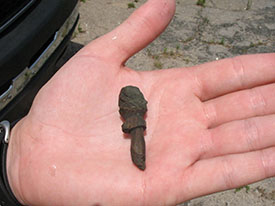
A wooden peg excavated from the amidships unit. (Large View)
Teams were broken off into separate groups again Thursday. One group went with Greg Cook to help locate an anchor lost by a local member of the coast guard. This was a good opportunity to practice metal detecting skills as well as circle searches, while helping the community. On par with a week of great luck with weather and finds, Helen Welch and Greg found the anchor on the last circle of the last search of the day. The rest of the dive teams continued excavating EPII from the barge, working in the amidships and stern units. A beautiful concretion was found in the south unit along with uncovering more ceiling planking in the hull. In the amidships unit, they progressed to the third level and spent much of their dive removing very large ballast stones. Some pieces were so large they had to be chiseled apart to be removed from the unit safely. Two pieces of ceramic were also found and mapped in, along with a hand-carved wooden peg that somewhat resembles a chess piece, found by supervisor Sarah Linden.
This Friday was a half-day as usual, to leave time to clean up the Marine Services Center and the vehicles we use everyday in our pursuit of amazing archaeological adventures. Some of the teams were modified today to allow some divers to dive the first Emanuel Point wreck, excavated in the 1990s. While a small group of divers were measuring EPI and enjoying the good visibility, the rest of the teams were also enjoying a day of uncharacteristically good visibility on EPII. In the southern unit, detailed mapping was being done to record the stern of the vessel. In the amidships unit, the teams delved deeper into the ship’s belly, uncovering more ceramics, wood fragments and a large, interesting piece of coral. The wind picked up early and the current got strong half way through the morning. Our last dives were somewhat rushed, so that we could all get safely out of the water. Once we went back to the Marine Services Center, we began our diligent tasks of cleaning the salt off all our equipment. As we looked through our dredge spoil from the day, a rat skull was found among the oyster shells, rocks, and the other usual debris. This was a great find to end a productive week.
Students examine their dredge spoil for artifacts at Marine Services Center. Left to Right: Andy Marr, Matt Gifford, Chris Dvorscak, Mercedes Harrold, Sarah Everhart, and John Smith. Click on the image to zoom in for a closer look.
Please feel free to contact us if you have any questions or concerns at: mua@keimaps.com.
Return to Project Journal home page.
